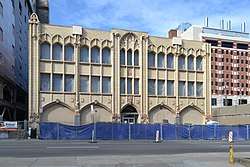Croatian Fraternal Union Building
The Croatian Fraternal Union Building is a historic building in the Oakland neighborhood of Pittsburgh, Pennsylvania. It is the former headquarters of the Croatian Fraternal Union, the oldest and largest Croatian organization in North America, and a significant site in Croatian American history. The building was designed by Pierre A. Liesch in the Flemish Gothic Revival style and built in 1928–9.
| Croatian Fraternal Union Building | |
|---|---|
 The building in October 2018 | |

| |
| General information | |
| Location | 3441 Forbes Ave. Pittsburgh, Pennsylvania |
| Coordinates | 40°26′22″N 79°57′37″W |
| Construction started | 1928 |
| Completed | 1929 |
| Owner | University of Pittsburgh[1] |
| Design and construction | |
| Architect | Pierre A. Liesch |
History
The Croatian Fraternal Union (CFU) began as the Croatian Association, chartered in 1894 in Allegheny, now Pittsburgh's North Side. It was re-chartered in 1897 as the National Croatian Society and then merged with three other organizations in 1926 to form the CFU.[2] The organization offered life, accident, and health insurance for its members, as well as social and cultural services including scholarships and sports programs.[3] By 1928, it had over 80,000 members.[4]
After the 1926 merger, the CFU needed a new headquarters to consolidate its operations. Both of its existing facilities—the old NCS building on the North Side, and the Chicago offices of the Croatian League of Illinois—were inadequate for the new, larger organization. Delegates to the first CFU convention in May 1926 decided to sell the old offices and build or buy a new one.[5] In 1928, the organization commissioned a new Home Office building on Forbes Avenue in Oakland. The Pittsburgh Press reported that the "architecture of the building will be Gothic and leaning towards the Cathedral of Learning style, and will be in keeping with the cultural atmosphere of the Schenley district."[4]
The building was dedicated on January 20, 1929, with a speech from Pittsburgh mayor Charles H. Kline.[6] It was the first building designed specifically to meet the needs of the organization and included an auditorium and meeting hall as well as office space.[3] In 1961, the CFU moved to a new headquarters in Wilkins Township[2] and the Forbes Avenue building was sold to Allegheny County. It housed county Health Department facilities for many years. The University of Pittsburgh bought the building in July 2018 for $1.9 million and filed for a demolition permit in August.[1] In October, it was nominated as a city historic landmark by Preservation Pittsburgh.[3]
Architecture
The CFU building is a three-story, flat-roofed structure of brick, steel, and concrete construction. It was designed by Luxembourg-born Pittsburgh architect Pierre A. Liesch (1872–1954) in a Flemish Gothic Revival style. Liesch was also credited as a consulting architect on the Union Trust Building (1916), which showed a similar Flemish influence. The principal facade faces southeast toward Forbes Avenue and is clad in gold terra cotta tile with rust-colored accents. The facade is symmetrical and is divided into five bays by vertically ribbed responds which run the full height of the building. The first floor has an arcade of five pointed arches, with the central arch housing the entry doors. The side arches were originally plate-glass storefronts with their own individual entrances, but were later filled in with terra cotta blocks to form a blind arcade. The main entrance was also altered from the original carved wooden doors with stained-glass sidelights and transom to a more utilitarian aluminum-framed entrance.
The second and third stories have three windows per bay, separated by vertical ribbing. The third-floor windows have the form of Gothic pointed arches, while those on the second floor are rectangular. The parapet above the third-floor windows is ornamented with Gothic tracery including a large tripartite pointed arch above the entrance bay. The building was originally crowned with a highly ornate overhanging cornice and a pointed-arch apex topped with a sculptural element, but this has been replaced with a plain brick parapet. Truncated corbeled arches that supported the cornice are still present. The responds were terminated with ornamented pinnacles, though only one is still present as of 2018. Other terra cotta ornamentation includes seals of the United States and Pennsylvania, escutcheons, scrollwork, floral patterns, heraldic dolphins, a crowned head, and sculpted figures of a rope-maker and a miner, representing common occupations for Croatian immigrants.[3][7]
References
| Wikimedia Commons has media related to Croatian Fraternal Union Building. |
- Schooley, Tim (August 13, 2018). "University of Pittsburgh files for demolition of Forbes Avenue building". Pittsburgh Business Times. Retrieved October 13, 2018.
- "About CFU: History". Croatian Fraternal Union of America. Retrieved October 13, 2018.
- "City of Pittsburgh Historic Landmark Nomination: Former Croatian Fraternal Union" (PDF). Preservation Pittsburgh. October 2018. Retrieved October 13, 2018.
- "New Oakland Building". Pittsburgh Press. February 28, 1928. Retrieved October 13, 2018 – via Newspapers.com.
- Čizmić, Ivan (1994). History of the Croatian Fraternal Union of America 1894–1994. Zagreb: Golden Marketing. pp. 209–213. ISBN 953-6168-02-2.
- "Croatian Fraternal Body Dedicates New Home". Pittsburgh Press. January 21, 1929. Retrieved October 13, 2018 – via Newspapers.com.
- "Pennsylvania Historic Resource Survey Form: Allegheny County Health Department" (PDF). Pittsburgh History & Landmarks Foundation. September 24, 1980. Retrieved October 15, 2018.